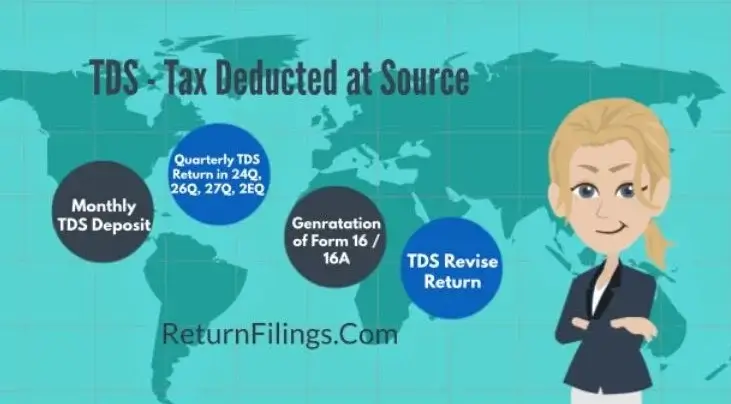TDS & TCS Rates and Compliance for FY 2024-25 & 2025-26: Filing & Amendments
1. Introduction
Tax Deducted at Source (TDS) and Tax Collected at Source (TCS) are key components of India’s taxation system. These provisions ensure timely tax collection and help the government prevent tax evasion. This guide provides updated TDS and TCS rates for the financial years 2024-25 and 2025-26, along with examples and case studies to enhance understanding.
2. TDS Rates for FY 2024-25 & FY 2025-26
The following table outlines the applicable TDS rates under different sections of the Income Tax Act:
2.1 TDS Rates on Salary and Other Payments
| Section | Nature of Payment | Threshold Limit (INR) | TDS Rate (%) |
|---|---|---|---|
| 192 | Salary | As per income slab | As per income slab |
| 192A | Premature withdrawal from EPF | 50,000 | 10 |
| 193 | Interest on securities | 10,000 (Individual), 5,000 (Others) | 10 |
| 194 | Dividend | 5,000 | 10 |
| 194A | Interest (Banks, Post Office) | 40,000 (Individual), 50,000 (Senior Citizens) | 10 |
| 194C | Payment to contractors | 30,000 (Single), 1,00,000 (Annual) | 1 (Individuals), 2 (Others) |
| 194D | Insurance Commission | 15,000 | 5 |
| 194H | Commission/Brokerage | 15,000 | 5 |
| 194I | Rent (Land & Building) | 2,40,000 | 10 |
| 194J | Professional Fees | 30,000 | 10 |
| 194N | Cash Withdrawal | 1 Crore (General), 20 Lakhs (Non-ITR Filers) | 2-5 |
| 206AB | Special rate for non-filers of ITR | - | Higher of 5% or twice the normal rate |
3. TCS Rates for FY 2024-25 & FY 2025-26
Certain sellers collect tax at the source while receiving payments. Here’s a breakdown of the applicable TCS rates:
3.1 TCS Rates on Goods and Services
| Section | Nature of Payment | Threshold Limit (INR) | TCS Rate (%) |
|---|---|---|---|
| 206C(1) | Sale of Alcoholic Liquor | - | 1 |
| 206C(1) | Sale of Timber | - | 2.5 |
| 206C(1) | Sale of Minerals (Coal, Lignite, Iron Ore) | - | 1 |
| 206C(1F) | Sale of Motor Vehicles (Above 10 Lakhs) | 10 Lakhs | 1 |
| 206C(1H) | Sale of Goods (Turnover > 10 Crore) | 50 Lakhs | 0.1 |
| 206CCA | Special rate for non-filers of ITR | - | Higher of 5% or twice the normal rate |
4. Case Studies and Examples
Example: TDS on Salary
Mr. ABC earns INR 12,00,000 annually. As per the income tax slab, his employer deducts TDS under Section 192 based on applicable rates.
Example: TCS on High-Value Car Purchase
Ms. DEF buys a car worth INR 15,00,000. The dealer collects 1% TCS under Section 206C(1F) and deposits it with the government.
5. Compliance and Filing Requirements & consequences of late filing
5.1 Filing requirements
• TDS Payment Due Date: 7th of the next month
• TCS Payment Due Date: 7th of the next month
• TDS Return Filing: Quarterly (31st July, 31st October, 31st January, 31st May)
• TCS Return Filing: Quarterly (15th July, 15th October, 15th January, 15th May)
Late filing attracts penalties under Sections 234E and 271H.
5.2 consequences of late filing
Delay in filing TDS/TCS returns can lead to significant financial and compliance consequences under the Income Tax Act, 1961. As per Section 234E, a late fee of ₹200 per day is levied for the delay in filing, subject to the total amount of TDS/TCS deductible or collectible. Additionally, if the return is not filed within one year from the due date or if incorrect details are submitted, the Assessing Officer may impose a penalty under Section 271H, ranging from ₹10,000 to ₹1,00,000. These penalties are over and above the late filing fee. Timely and accurate filing of TDS/TCS returns is therefore critical to avoid monetary losses and ensure continued compliance with tax regulations.
6. Recent Amendments
a. Increased TCS on Overseas Remittances: 20% TCS applicable on foreign tour packages and LRS remittances exceeding INR 7 lakh.
b. New TDS Provisions for E-commerce Sellers: Platforms to deduct 1% TDS on payments to sellers.
c. Tighter Rules for Non-Filers: Higher TDS/TCS for individuals who haven’t filed ITR in the last two years.
7. Conclusion
Understanding TDS and TCS is crucial for compliance and tax planning. Businesses and individuals should stay updated on these provisions to avoid penalties and ensure smooth financial transactions.
By adhering to the above compliance requirements, avoid penalties, and maintain good legal standing. For professional assistance, reach out to us on email: info@returnfilings.com or on whatsapp: https://wa.me/919910123091 to ensure all statutory obligations are met on time.
frequently asked questions (faq's) related to TDS/TCS return filing and Compliance
Q What is TDS (Tax Deducted at Source)?+
A TDS is a mechanism where a specified percentage of income is deducted by the payer at the time of making payment to the payee. This deducted amount is then deposited with the government. It's a way of ensuring tax collection at the source of income.
Q What is TCS (Tax Collected at Source)?+
A TCS is a mechanism where the seller collects tax from the buyer at the time of sale of certain specified goods and deposits it with the government. It's similar to TDS but collected by the seller.
Q What is the difference between TDS and TCS?+
A The key difference is who deducts or collects the tax: TDS is deducted by the payer, while TCS is collected by the seller. They apply to different types of transactions and at different points in the transaction process.
Q Why are TDS and TCS important?+
A TDS and TCS help prevent tax evasion, ensure a regular flow of tax revenue to the government, and allow tracking of financial transactions.
Q Who is required to deduct TDS?+
A Any person making specified payments (such as salary, rent, professional fees) exceeding certain thresholds is required to deduct TDS. This includes individuals, businesses, and organizations.
Q On what payments is TDS deducted?+
A TDS is deducted on payments including salaries, rent, professional fees, interest, commission, and payments to contractors.
Q What are the TDS rates?+
A TDS rates vary depending on the type of payment and the payee's tax status. Refer to the Income Tax Department website for the latest rates.
Q What are the TDS return filing requirements?+
A TDS returns (Form 24Q, 26Q, 27Q, 27EQ) are filed quarterly, providing details of TDS deducted and deposited.
Q What is the due date for filing TDS returns?+
A The due dates for TDS returns are:
Quarter 1 (April-June): July 31
Quarter 2 (July-Sept): October 31
Quarter 3 (Oct-Dec): January 31
Quarter 4 (Jan-March): May 31
Q What is a TDS certificate (Form 16, 16A)?+
A A TDS certificate is issued by the deductor to the deductee, showing the amount of TDS deducted. Form 16 is for salary TDS, and Form 16A is for non-salary TDS.
Q What happens if TDS is not deducted or deposited?+
A Failure to deduct or deposit TDS can lead to penalties, including fines and interest.
Q Who is required to collect TCS?+
A Specified sellers of certain goods (such as alcohol, timber, scrap) are required to collect TCS from the buyer.
Q On what sales is TCS collected?+
A TCS is collected on the sale of various goods as specified by the Income Tax Act.
Q What are the TCS rates?+
A TCS rates vary depending on the type of goods. Refer to the Income Tax Department website for the latest rates.
Q What are the TCS return filing requirements?+
A TCS returns (Form 27EQ) are filed quarterly, providing details of TCS collected and deposited.
Q What is the due date for filing TCS returns?+
A The due dates for TCS returns are the same as for TDS returns (July 31, October 31, January 31, May 31).
Q What is a TCS certificate (Form 27D)?+
A A TCS certificate is issued by the seller to the buyer, showing the amount of TCS collected.
Q What happens if TCS is not collected or deposited?+
A Failure to collect or deposit TCS can lead to penalties, including fines and interest.
Q How do I file TDS/TCS returns online?+
A TDS/TCS returns are filed online through the Income Tax Department's e-filing portal.
Q What are the different sections under Form 26AS?+
A Form 26AS is an annual tax statement showing TDS/TCS credits, tax paid by the assessee, and other tax-related information.
Q How do I download Form 26AS?+
A You can download Form 26AS from the Income Tax Department's e-filing portal.
Q What is the due date for depositing TDS/TCS?+
A TDS/TCS must be deposited by the 7th of the following month in which it is deducted or collected.
Q How do I correct errors in TDS/TCS returns?+
A Errors can be rectified through revised returns.
Q What are the penalties for late filing of TDS/TCS returns?+
A Penalties vary depending on the delay and the nature of non-compliance.
Q How can I find the TDS/TCS rates for a specific transaction?+
A Refer to the Income Tax Department's website or consult with a tax professional for the latest rates.
Q What are the regulations regarding TDS on salary payments?+
A Detailed regulations are available on the Income Tax Department's website.
Q How do I reconcile TDS/TCS data?+
A Reconciliation involves comparing the TDS/TCS deducted or collected with the amounts shown in Form 26AS.
Q Where can I find the latest TDS/TCS notifications and circulars?+
A The Income Tax Department's website is the official source for notifications and circulars.
- For further reading, explore the following topics:
- 📑 Compliance steps related to director removal in India
- ⚖️ Legal process for curing director disqualification
- 📝 Complete Process of Forming an HUF in India: Tax Implications & Legal Framework
- 🏭 Producer Company Registration Process in India: Requirements, Tax Considerations & Advantages

